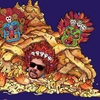Tom Robbins, at a 2014 reading of his memoir Tibetan Peach Pie at Powell’s Books at Cedar Hills Crossing in Beaverton, Ore.
Alex Milan Tracy/AP
hide caption
toggle caption
Alex Milan Tracy/AP

Tom Robbins, at a 2014 reading of his memoir Tibetan Peach Pie at Powell’s Books at Cedar Hills Crossing in Beaverton, Ore.
Alex Milan Tracy/AP
Tom Robbins dazzled millions of readers with the whimsy and imagination in his bestselling novels, such as 1984’s Jitterbug Perfume, Skinny Legs and All, from 1990, and Even Cowgirls Get the Blues, a 1976 book adapted by director Gus Van Sant into a 1993 film.
Robbins died at his home in La Conner, Washington, according to a statement from friend Craig Popelars. He was 92.
Tom Robbins lived in Washington state for most of his adult life, but he was born in Blowing Rock, N.C. His family moved around the South, settling in Warsaw, Va., where he picked up a knack for storytelling. As a boy, he would tell stories aloud to himself, outside, with a stick in his hand.
“I would beat the ground as I told the story,” he told NPR in 2014. “And we moved fairly frequently. We would leave houses behind where one section of the yard was completely bare from where I destroyed the grass. But I realized much later in life that what I was doing was drumming. I was building a rhythm.”
Along with the rhythm and humor in his novels, Robbins authored essays on subjects ranging from the life of an amoeba to Eastern philosophy. He said he often got ideas from periodicals.
“I do a lot of useless reading and read a lot of science magazines,” he explained to NPR in 1994. “I subscribe to about 30 magazines, and every Thursday night, I put on a satin smoking jacket that I bought in a second-hand store on Melrose Avenue in Los Angeles, and light up a big Cuban cigar and read magazines. And it is as if your mind is a Geiger counter. Every now and then, something makes a loud ping.”
In his 2014 memoir, Tibetan Peach Pie, Robbins wrote that he began taking LSD in 1964. Certainly, the eccentric characters and bizarre situations in his novels reflect a hallucinatory vision. In his debut novel, Another Roadside Attraction from 1971, the mummified body of Jesus Christ turns up at a roadside hot dog stand. His 1980 novel, Still Life with Woodpecker takes place inside a pack of Camel Cigarettes.
As a result, critics tended to pigeonhole him as a trippy hippy. “Establishment critics to this day write me off as a counterculture writer, even though [of] my nine novels, the last six have had nothing to do with counterculture themes,” Robbins said in 2014. “I wouldn’t have missed, say, the ’60s, for a billion dollars, but neither I nor my life’s work can be defined by counterculture sensibilities.”
Longtime University of St. Joseph professor Catherine E. Hoyser, now a professor emeritus, authored a guide to Robbins’ novels for students. She agrees that the scope and ambitions of his work far exceed his college-dorm-room reputation. “People who believed that he was a drug-taking bon-vivant that wasn’t particularly serious in his work actually don’t pay attention to the profound nature underneath that humor,” she says.
Underneath the fantasy and whimsy, Hoyser says Robbins was an advocate for feminism, social justice and the environment. She singles out his 1994 novel, Half Asleep in Frog Pajamas, in which frogs are disappearing: “He was writing about this well before people were even noticing the decline of species on our planet from climate change.”
In 1994, Robbins said his intention in that novel was to address far more than the disappearance of frogs. “I tried in a somewhat oblique, I hope non-didactic fashion, to establish a correlation between the disappearance of the frogs and the disappearance of the middle class, because the middle class is also disappearing from the planet,” he said. “And I guess the connection is that just as frogs are a bridge between water and land and between fish and reptiles, and maybe between the stars and planet Earth, so the middle class is a bridge between abundance and scarcity.”
Ultimately, what made Robbins who he was, perhaps, were his meticulously crafted sentences. “I guess when all is said and done, what I’m really interested in — what really throws the logs on my fire — is language,” he said.
The language a writer uses, Robbins said — dense, sparkling, brilliant, evocative and seductive — was ultimately more important than their message.





